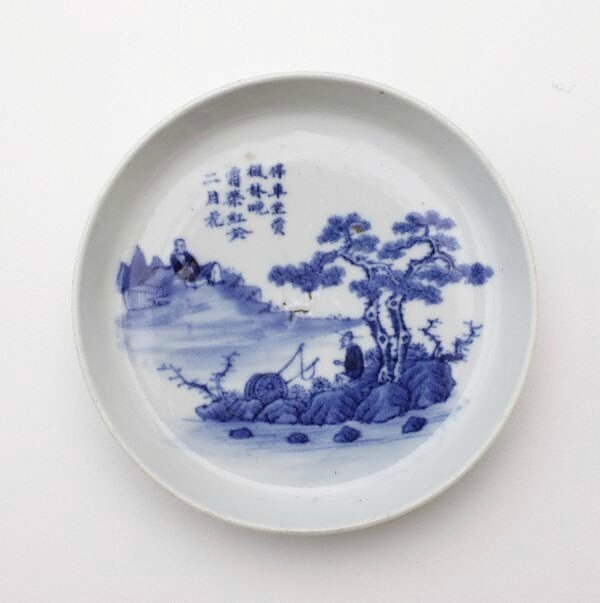Four Bleu de Huê in Art Gallery of New South Wales, Sydney
Bleu de Huê bowl with dragon decoration, Qing dynasty (1644–1911), Export ware for Viet Nam, circa 19th century-20th century, porcelain with underglaze decoration, 5.1 x 10.9 cm. Gift of Dr John Yu & Dr George Soutter 2002, 168.2002. Art Gallery of New South Wales, Sydney (C) Art Gallery of NewSouth Wales, Sydney
Along the rim of the bowl is a dragon with bulging eyes spitting fire. Near the shallow ring foot is a band of waves from which two carps emerge, one of which is blowing a huge gourd-shaped bubble.
From the 1700s onwards, kings of the Le-Trinh dynasty in Vietnam ordered porcelain pieces from China for their court. This type is named after Hue, the 19th-century capital of the last royal dynasty in Vietnam, the Nguyen dynasty (1802-1945). Although Chinese artisans executed the painting, Vietnamese rulers dictated the designs. Each ruler ordered ceramics of his own liking for use in his court, as well as presentation pieces to give to members of royal families and mandarin officials.
Asian Art Department, AGNSW, January 2012
Bleu de Hue dish decorated with cranes and pine trees, Qing dynasty (1644–1911), Export ware for Viet Nam, circa 19th century-20th century, porcelain with underglaze decoration and metal rim, 1.9 x 16.4 cm. Gift of Dr John Yu & Dr George Soutter 2002, 169.2002. Art Gallery of New South Wales, Sydney (C) Art Gallery of NewSouth Wales, Sydney
A lesser known Chinese export ware is 'bleu de Hue', blue-and-white porcelain made for the Vietnamese market from the 1700s, when kings of the Le-Trinh dynasty ordered wares from China for their court. The type is named after Hue, the 19th-century capital of the last royal dynasty in Vietnam, the Nguyen dynasty (1802-1945). Although Chinese artisans executed the painting, the Vietnamese rulers dictated the designs. Each ruler ordered ceramics of his own liking for use in his court, as well as presentation pieces to give to members of the royal families and mandarins.
The Asian Collections, AGNSW, 2003, pg.145.
Bleu de Hue' saucer dish, China, Qing dynasty (1644–1911), Export ware for Viet Nam, mark "In the collection of Roushen", porcelain, 2.7 x 14.4 cm. Gift of Elisabeth M. Smith 2002, 292.2002. Art Gallery of New South Wales, Sydney (C) Art Gallery of NewSouth Wales, Sydney
The small porcelain dish is decorated on the interior in blue and white with a charming landscape with figures. A scholar is seated reclining against a rock, gazing far into the distance. His servant sits opposite him under two trees next to a jinrikisha. Two lines of poem by the renowned Tang dynasty poet Du Mu (803-852) appear on the upper left corner, and read: Stopping my cart, I sit and enjoy the maples at twilight; the red autumn leaves surpass February's flowers.' The decoration vividly demonstrates the intermingled taste of the literati and the populace.
A four character mark in cobalt blue is seen on the bottom of the dish. The first two characters of the four character mark, 'Nuoshen zhencang', could be the name of a person or a studio or they could simply mean 'deeply'. The second two characters mean 'treasure of' or 'treasured'. The dish was a product of Jingdezhen, manufactured around the Kangxi period of the Qing dynasty.
Asian Art Department, AGNSW, 15 October 2002.
NDB: Malgré le fait que la marque "In the collection of Roushen" soit assimilée pour les pièces chinoises à la période Kangxi, les bleus de Huê sont de la période Tu Duc (1848-1883).
'Bleu de Hue' bowl with landscape painting and poem, 18th century-19th century, Qing dynasty (1644–1911), Export ware for Viet Nam, mark "Longevity", porcelain with underglaze blue decoration and a metal band around the rim, 3.7 x 11.5 cm. Gift of Max and Cynthia Loveday 2011, 128.2011. Art Gallery of New South Wales, Sydney (C) Art Gallery of New South Wales, Sydney
The poem on this bowl refers to an aspect of Chinese philosophy which maintains that if one understands the meaning of something, the vehicle that led to this understanding is unimportant (eg if you truly understand music then the sound itself becomes irrelevant). This piece resembles the ‘bleu de Hue’ wares exported to Viet Nam. The French term 'bleu de Hue' (literally, 'the blue of Hue') refers to the blue and white porcelain commissioned for the Vietnamese court in Hue during the Nguyen dynasty (1802–1945). The porcelain was produced at the kilns of Jingdezhen in Jiangxi province.
Asian Art Department, AGNSW, September 2011

/https%3A%2F%2Fprofilepics.canalblog.com%2Fprofilepics%2F1%2F0%2F100183.jpg)
/https%3A%2F%2Fstorage.canalblog.com%2F03%2F02%2F119589%2F96711876_o.jpg)
/https%3A%2F%2Fstorage.canalblog.com%2F11%2F31%2F119589%2F94773502_o.jpg)
/https%3A%2F%2Fstorage.canalblog.com%2F20%2F83%2F119589%2F94772815_o.jpg)
/https%3A%2F%2Fstorage.canalblog.com%2F26%2F72%2F119589%2F75604929_o.jpg)
/https%3A%2F%2Fstorage.canalblog.com%2F59%2F60%2F119589%2F26458628_o.jpg)










/http%3A%2F%2Fstorage.canalblog.com%2F16%2F03%2F119589%2F111347726_o.jpg)
/http%3A%2F%2Fstorage.canalblog.com%2F28%2F15%2F119589%2F107236334_o.jpg)
/http%3A%2F%2Fstorage.canalblog.com%2F66%2F08%2F119589%2F107235973_o.jpg)
/http%3A%2F%2Fstorage.canalblog.com%2F19%2F84%2F119589%2F107235629_o.jpg)